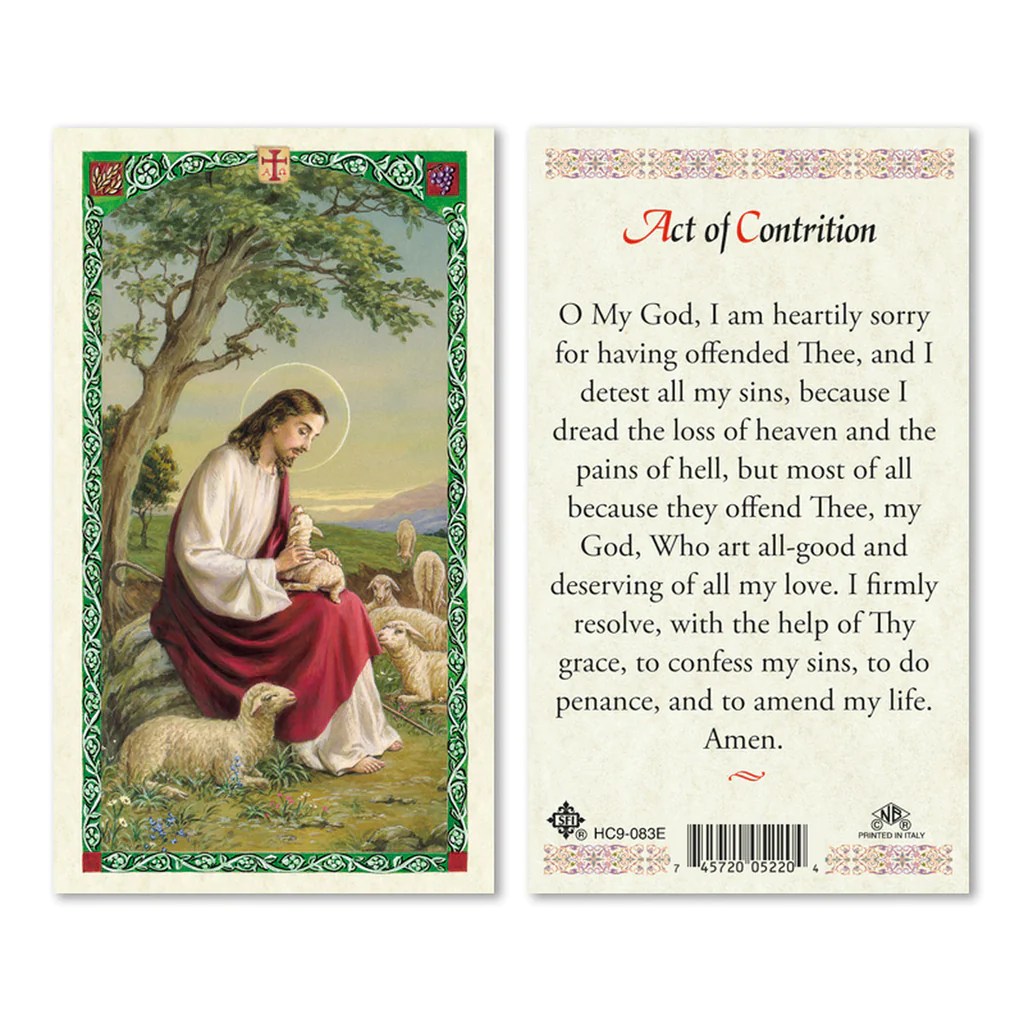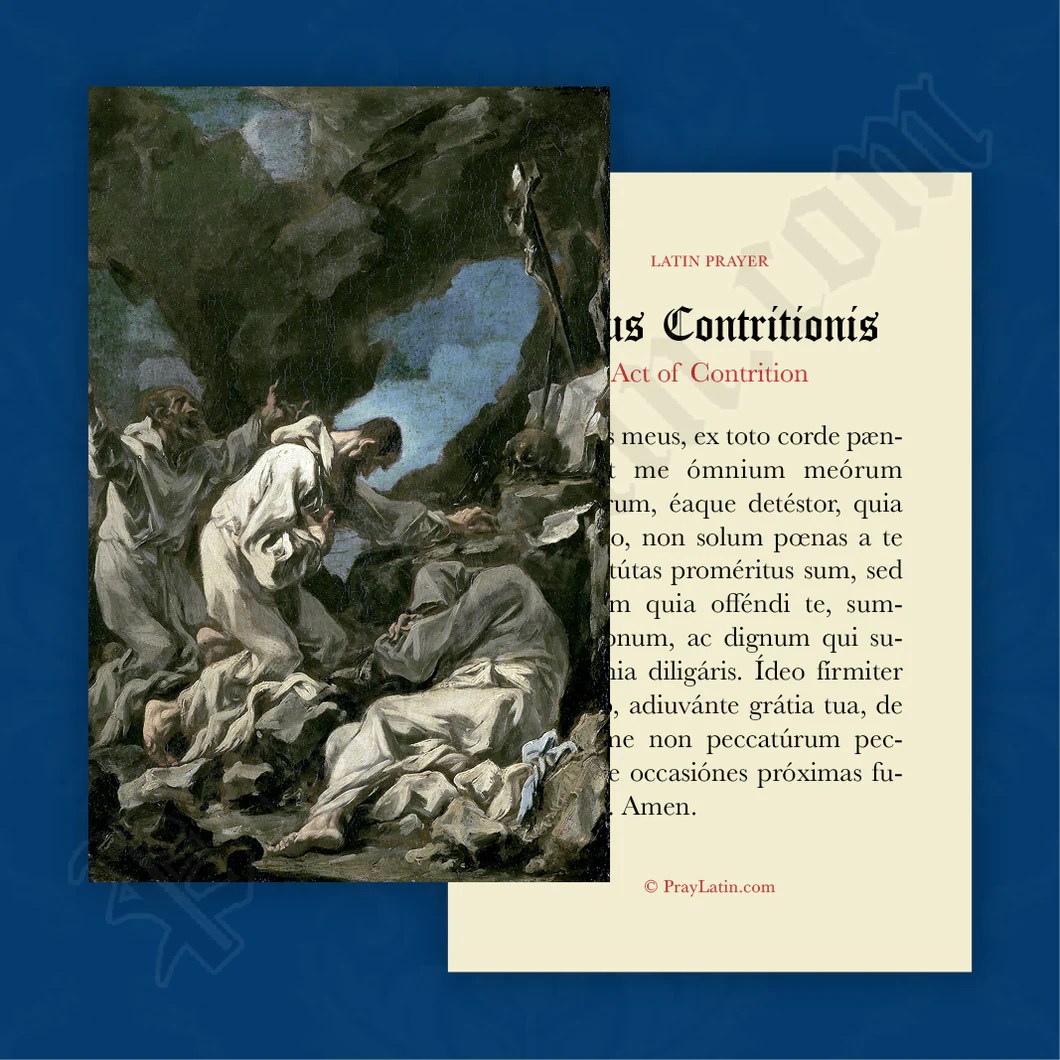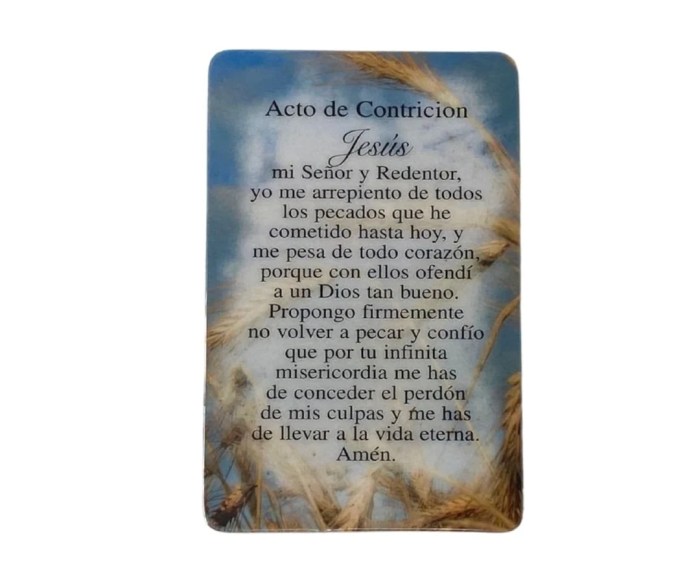Embark on a captivating journey into the Act of Contrition in Spanish, a profound prayer that holds immense significance in the Catholic faith. This exploration delves into its cultural and historical context, common forms, and contemporary interpretations, offering a comprehensive understanding of its role in Spanish-speaking communities.
From its origins to its diverse expressions, the Act of Contrition has played a pivotal role in shaping religious practices and literary works in Spanish-speaking cultures. Join us as we uncover the essence of this heartfelt prayer and its enduring impact.
Meaning of Act of Contrition in Spanish

The Act of Contrition is a prayer of repentance and sorrow for sins committed. It is a fundamental part of the Catholic faith, as it expresses the believer’s acknowledgment of their wrongdoing and their desire to turn away from sin and towards God.
Cultural and Historical Context
In Spanish-speaking communities, the Act of Contrition has a long and rich history. It has been recited for centuries as a way to express repentance and to seek forgiveness for sins. The prayer is often said before Confession, as a way to prepare the heart for the sacrament.
Common Forms of the Act of Contrition in Spanish

The Act of Contrition is a prayer of repentance that is commonly used in the Catholic Church. It is typically recited before receiving the sacrament of Reconciliation (also known as Confession). There are several different versions of the Act of Contrition in Spanish, but they all share the same basic elements: a confession of sin, an expression of sorrow for sin, and a request for forgiveness.
Traditional Form
The traditional form of the Act of Contrition in Spanish is as follows:
Señor mío Jesucristo, Dios y Hombre verdadero, Creador, Padre y Redentor mío; por ser Vos quien sois, Bondad infinita, y porque os amo sobre todas las cosas, me pesa de todo corazón haberos ofendido; propongo firmemente nunca más pecar, confesarme y cumplir la penitencia que me fuere impuesta. Amén.
This version of the Act of Contrition is relatively long, but it is also very thorough. It includes a confession of sin, an expression of sorrow for sin, a request for forgiveness, and a resolution to avoid sin in the future.
Short Form
There is also a shorter form of the Act of Contrition in Spanish, which is as follows:
Dios mío, me arrepiento de todo corazón de haberte ofendido. Perdóname, Señor, por tu infinita misericordia. Amén.
This version of the Act of Contrition is shorter and simpler than the traditional form, but it still includes all of the essential elements: a confession of sin, an expression of sorrow for sin, and a request for forgiveness.
Similarities and Differences, Act of contrition in spanish
The traditional and short forms of the Act of Contrition in Spanish are both valid prayers. The traditional form is more thorough, while the short form is simpler. Both forms are acceptable for use in the sacrament of Reconciliation.
The Act of Contrition in Spanish Culture

The Act of Contrition is an essential element in Spanish-speaking cultures, reflecting the deep-rooted Catholicism and spiritual beliefs. It serves as a way for individuals to acknowledge their sins, express remorse, and seek forgiveness from God.
Role in Religious Practices
The Act of Contrition plays a significant role in Catholic rituals, particularly in the sacrament of Confession. During Confession, individuals confess their sins to a priest and recite the Act of Contrition as a sign of their repentance and desire for forgiveness.
It is also a common practice to recite the Act of Contrition as part of daily prayers and devotions, such as the Rosary or the Divine Mercy Chaplet.
The Act of Contrition in Spanish Literature

The Act of Contrition, a prayer expressing remorse for sins, has been a prominent element in Spanish literature for centuries. Its use in literary works reflects the deep-rooted Catholic faith in Spanish society and its influence on cultural expression.
Incorporation into Literary Works
Spanish literature often incorporates the Act of Contrition as a literary device to convey themes of guilt, redemption, and spiritual struggle. Authors have employed it in various ways, including:*
-*As a character’s internal monologue
The Act of Contrition can reveal the inner turmoil and self-examination of characters grappling with their sins and seeking forgiveness.
-
-*As a catalyst for plot development
The Act of Contrition can trigger pivotal moments in a narrative, leading to characters’ transformations or setting the stage for significant events.
-*As a symbol of religious and cultural values
The Act of Contrition represents the deeply held beliefs and practices of Spanish society, serving as a reflection of the religious and cultural context in which literary works are created.
Examples in Spanish Literature
*
-*Miguel de Cervantes’ “Don Quixote”
In this classic novel, Don Quixote recites the Act of Contrition before his death, expressing his regret for his past actions and seeking divine mercy.
-
-*Federico García Lorca’s “Blood Wedding”
For those seeking a deeper understanding of the act of contrition in Spanish, there are various resources available. In addition, if you’re preparing for your Virginia DMV driving test, consider taking a dmv signs practice test va to enhance your knowledge of road signs.
Returning to the topic of contrition, it’s essential to remember the importance of genuine repentance and seeking forgiveness for one’s actions.
The play incorporates the Act of Contrition as a recurring motif, highlighting the characters’ guilt and the tragic consequences of their actions.
-*Camilo José Cela’s “The Hive”
This novel features a passage where a group of characters collectively recite the Act of Contrition, emphasizing the collective guilt and suffering experienced by Spanish society during the Francoist dictatorship.
Modern Interpretations of the Act of Contrition in Spanish

In contemporary Spanish-speaking communities, the Act of Contrition has undergone significant interpretations to reflect evolving social and religious contexts. These adaptations have sought to make the Act more inclusive, accessible, and relevant to the lived experiences of modern-day Catholics.
One notable interpretation is the emphasis on communal responsibility and forgiveness. In traditional forms of the Act, the focus was primarily on individual sins and repentance. However, contemporary interpretations recognize the collective nature of sin and the importance of seeking forgiveness not only from God but also from one another.
Emphasizing Social Justice
Another modern interpretation involves incorporating themes of social justice into the Act of Contrition. This adaptation acknowledges the interconnectedness of sin and social structures that perpetuate injustice and inequality. It encourages individuals to examine their actions and attitudes in light of their impact on others and the wider community.
Focus on Inclusivity
In recent years, there has been a growing emphasis on making the Act of Contrition more inclusive. This includes using gender-neutral language and recognizing the diversity of experiences and perspectives within the Catholic community. By doing so, the Act seeks to create a more welcoming and compassionate space for all.
Popular Questions
What is the significance of the Act of Contrition in the Catholic faith?
The Act of Contrition is a prayer that expresses sorrow for sins committed and seeks God’s forgiveness. It is considered an essential part of the sacrament of Reconciliation, where Catholics confess their sins to a priest.
How does the cultural and historical context influence the Act of Contrition in Spanish-speaking communities?
The Act of Contrition has been shaped by the cultural and historical experiences of Spanish-speaking communities. In these communities, the prayer has played a significant role in religious practices, such as confession and prayer, and has been incorporated into various literary works.
